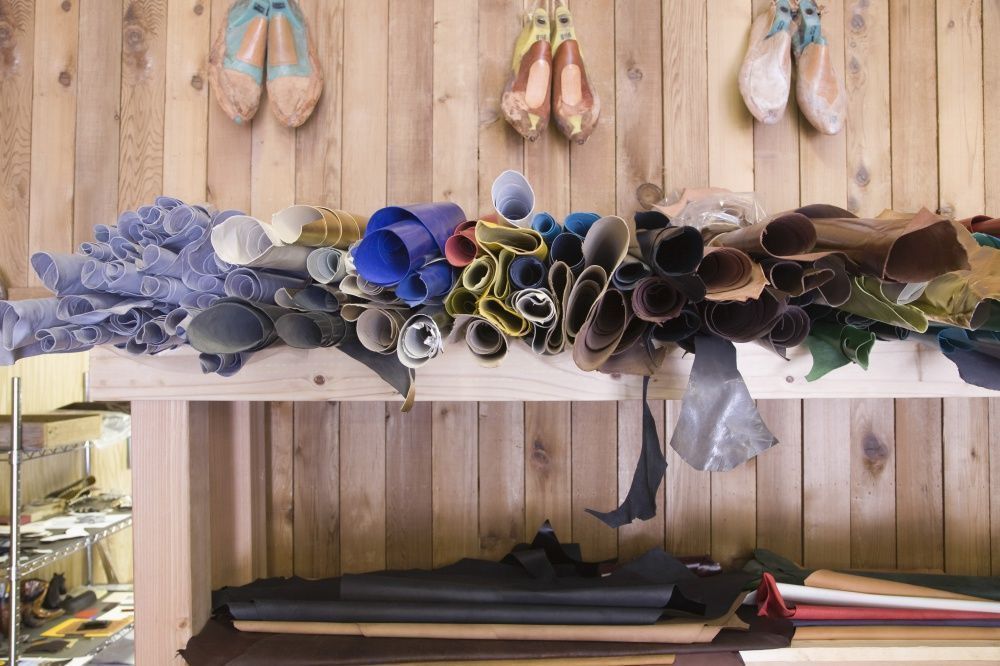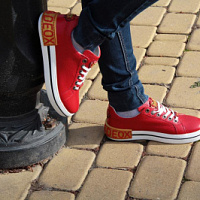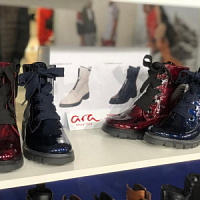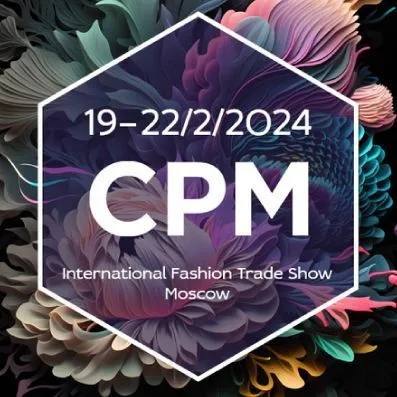
Russia will shoe itself ?!

In the context of anti-Russian economic sanctions and actively rising jingoistic patriotism, they are increasingly talking about a ban on the import of foreign clothing and footwear in order to stimulate the development of domestic production. "Russia will shoe itself!" - write users of social networks, not paying attention to the insidious play on words. What is the real situation in the domestic leather and footwear industry and whether Russia, if necessary, will be able to shoe itself, Shoes Report tried to figure it out, using the materials provided to us by the Russian Union of Leatherworkers and Shoemakers.
About industry
The Russian leather industry is one of the oldest domestic industries, it arose at the beginning of the 1721th century, even during the reign of Peter the Great (the reformer tsar in XNUMX issued his Decree banning the export of raw hides "... so that boots would be made of Russian leather ..." and put the beginning of the birth of industry).
This segment of the light industry is the only one, at present, which completely works on Russian raw materials, provides natural leather for the production of footwear (including for the Armed Forces), leather goods, furniture, cars; is socially significant, since enterprises located in many regions of the country are often city-forming.
Many enterprises have a long history and good traditions in leather and shoe production. Of course, the industry has undergone reconstruction several times, but over the past two decades it has made a breakthrough: enterprises built before 1990 have been completely technically updated, a significant part of the obsolete equipment has been replaced by modern high-performance equipment that allows the production of competitive leather and shoes (up to 90% of materials are shoe industry), which are in demand among the population and abroad (export of leather and shoes is about 20% and 10%, respectively). At present, we have an updated domestic leather and footwear industry producing high-quality, competitive products.
Technologically, tanneries involve full-cycle processing, from raw hides to finished leather. In Russia today there are more than three dozen tanneries operating, producing over 220 million square meters. m genuine leather. A little more than half of the volume of raw materials is processed at two large plants, the remaining volumes are processed by medium and small enterprises. All tanneries are equipped with modern Italian, Czech and Spanish technological equipment.
Commodity issue
Raw materials for the leather industry are animal waste - cattle hides and insignificant volumes of hides of pigs, goats and sheep. The leather of small cattle (goats, sheep) in the world is used little because of their small area, small thickness, specific properties and high processing costs, and blue leathers have become more used in the food industry. Contrary to numerous suggestions, replacing cattle hides with other types of raw materials is not possible on an industry-wide scale. Russia is not in the top ten in livestock and leathers processing, located in the 12-13 place.
In 2014, by a decree of the Government of Russia, leather raw materials and semi-finished products were included in the List of goods that are essential for the domestic market of the Russian Federation, along with milk, grain, etc. The reason for this decision was the high social and defense significance of the product.
Historically, Russian enterprises use only domestic raw materials. It is lower in cost than European and this allows you to issue a high-quality final product at a very reasonable price, in addition, the import of raw leathers is limited by veterinary rules, the specificity of goods during transportation, as well as the introduction of export bans in many commodity countries. In 2001, at the insistence of tanneries, a high, almost prohibitive, duty was imposed on the export of raw hides from Russia, and in the next 10 years, the leather and footwear industry was very actively developing, showing an annual increase in volumes from 13% to 17%. However, other processes went in parallel. The number of livestock is declining every year, the borders with the countries of the Customs Union have opened, under the terms of the WTO, duties on the export of leather semi-finished products have decreased and annually reduced on raw leathers. All this has led to an increase in the export of raw materials: raw leathers –– through the border of Kazakhstan and tanning semi-finished products to EU countries. For domestic production, resources were sorely lacking. Abroad, Russian raw materials are in high demand for a low selling price (50-60% lower than US and European prices) and good quality.
Sad statistics
According to customs, in the 2012 year, 23,8 thousands of tons of semi-finished leather goods were exported from Russia, in 2013, already 27,4 thousand tons. In terms of raw materials, up to 30% of the best leather resources is exported, which leads to their shortage in the country. The main exporters of semi-finished products from Russia are raw material intermediary companies, simply speaking, resellers. Taking advantage of their position as raw material holders, they process it on a tolling basis at tanneries to a semi-finished product and export it mainly to Italy (up to 80%).
The smaller the resources, the lower the production of leather and shoes in the country. During 2012-2013, leather production decreased by 13,4%, leather shoes - by 14,7%. In 2014, there was no improvement. The current situation negatively affects the social aspect - employment in the industry. So, for the processing of a unit of raw materials to a semi-finished product, only one worker is needed, for the production of finished leather you need 6 people, and finished shoes need 24. The export of raw materials and semi-finished products leads to the loss of jobs.
According to statistics, in 2012-2013, the number of workers employed in this industry decreased by 7 thousand people, which increased social tensions in the regions and requires additional budgetary funds for unemployment benefits. According to a rough estimate, this amount is up to 490 million rubles annually.
Alternative ways
In this situation, it seems obvious the search for new sources of raw materials, including the import of raw materials from abroad. But here, too, is not easy. The use of European and American raw materials (raw leathers and semi-finished products) is not possible for economic reasons: as mentioned above, Western prices for 50-60% are higher than Russian ones. In the cost of finished leather, the share of raw materials is about half, so its purchase at a price of 50-60% higher than Russian will increase the cost of leather by 30%. With a tannery profitability of approximately 5,5% and an increase in prime cost by 30%, production would be unprofitable. This will lead to massive bankruptcy of enterprises.
The import of resources from raw countries is also not possible due to the introduction in these countries of restrictions and prohibitions on the export of raw materials and semi-finished products (India, Uzbekistan, China, Argentina and other countries), as well as veterinary restrictions on imports to Russia.
Neighboring countries, members of the Customs Union, cannot be sources of resources for Russian enterprises. In Belarus and Kazakhstan, manufacturers themselves lack leather raw materials and purchase them in Russia, reducing their already small volumes in our domestic market. In addition, through Kazakhstan's open borders, Russian raw materials are massively exported for cash to Kyrgyzstan, and then to China, leaving their own Kazakhstani enterprises, which produce only semi-finished products and export it also through Kyrgyzstan to China, without raw materials.
Emergency Measures
In this situation, manufacturers of leather and shoes (RSKO) appealed to the Government of the Russian Federation with a demand to pay attention to the state of this segment of the light industry and take protective measures. In August 2014 of the year, a temporary ban was introduced (until 1 of April 2015 of the year) on the export of a leather semi-finished product from Russia. According to experts, the preservation of raw materials will stabilize the leather market, increase leather production for domestic consumption and save about 2,3 billion rubles for the state budget.
Final product
Almost all Russian leather shoes are made from domestic raw materials. The export turnover of leather and shoe products in 2014 amounted to about 260 million dollars, which confirms the competitiveness of Russian goods. The volume of leather goods production in Russia per year is over 220 million square meters. From them you can make 80-90 million pairs of shoes. This, of course, is not enough to shod the whole country. But the latest market trends are such that leather shoes account for only a quarter of consumption.
Everything is determined by customer demand. According to official figures, Russia annually consumes about 455 million pairs of shoes. Of these, Russian-made - 115 million pairs. Of the total volume of shoes consumed by Russians every year, leather shoes account for more than 100 million pairs, that is, slightly more than 20%. The remaining shoes are made of artificial, textile materials, plastic, rubber and felt. If textiles, rubber and felt are successfully produced in our country, we have no production of artificial materials for shoe upper and raw materials for shoe bottom. Therefore, manufacturers buy either these materials or their blanks abroad: in China, Turkey and other countries.
The situation in the Russian leather and footwear industry is complicated. The development of domestic production depends on various factors and has many different aspects, but the main ones are just two: the availability of raw materials and the creation of equal competition for all players in the Russian leather and footwear market.
The presence of imports on the Russian market is necessary, since this is competition and the forward movement of our industry. But it is precisely the unequal competition that has been taking place for many years that is the main brake on the development of Russian production. For example, for more than 10 years, ready-made leather has been imported into the country at the price of raw materials (less than 5 dollars / sq.m), and the average contract price for imported shoes does not exceed 11 dollars per pair, while the minimum retail prices have already exceeded 40- 50 dollars / pairs In such conditions, it is difficult for Russian enterprises to hold positions, constantly reducing their profitability.
In order for Russia to shod itself, it is necessary for the state to create equal competitive conditions for both imports and production, but for now it is economically inefficient to produce in Russia, so the situation requires active participation and support of the state.
The main tanneries of Russia
- Bogorodsky factory of chrome leathers, Nizhny Novgorod region
- "VKP LT", Vyazma
- Chevret, Volgograd
- "Artex", Kirov
- "Wahrushi-Yuft", Kirov region
- Verkhnevolzhsky Tannery, Ostashkov
- "Raskom", Rasskazovo
- "Russian leather", g. Ryazan
- Rybinsk Tannery, Yaroslavl Region
- Serpukhov leather factory “Trud”, Moscow region
- Taganrog Tannery, Rostov Region
- Taldom Tannery, Moscow Region
- "Chrome", Yaroslavl
- Spassky Tannery, Ryazan Region
- "leather", St. Petersburg
- Khromtan, Bogorodsk
- "Bokoz", Nizhny Novgorod region
- Chevro, Voronezh Region
- Laika, Krasnodar Territory
- "Karista", Nalchik
- "Safyan", Kazan
| Please rate the article |
Materials on the topic
What is the mistake of suppliers of children's shoes in working with wholesale companies

How to work with marketplaces to avoid competition between the online assortment and the offline store

Brazilian shoe manufacturers invite buyers from Russia and CIS countries to business meetings in online format

DEOX strengthens its market position

Lillian Roor, ARA Sales Director in Russia: “ARA Shoes strives to be the most high-tech manufacturer of fashionable footwear.
Popular
 Coach turned to Big Data analysis and won the interest of a young audience
American handbag brand Coach has planned the success of its Tabby model among a younger audience, Generation Z, by turning to big data analysis, abandoning traditional and analogue tools, such as human intuition or the ability of any executive to sense “which way the wind will blow,” writes B.O.F.
Coach turned to Big Data analysis and won the interest of a young audience
American handbag brand Coach has planned the success of its Tabby model among a younger audience, Generation Z, by turning to big data analysis, abandoning traditional and analogue tools, such as human intuition or the ability of any executive to sense “which way the wind will blow,” writes B.O.F.
 IDOL updates the concept
The IDOL brand, part of the Melon Fashion Group portfolio, opened the first flagship in an updated concept in the Aviapark shopping center in Moscow.
IDOL updates the concept
The IDOL brand, part of the Melon Fashion Group portfolio, opened the first flagship in an updated concept in the Aviapark shopping center in Moscow.
 Seven “sins” of the shoe business. How do owners harm the company with their own hands?
Why is Company X able to create a strong, profitable brand, but Company Y is struggling to make ends meet? Many people prefer to attribute success to luck, luck, or the support of strong patrons. And few people ask themselves the question: “What am I doing wrong?” Moreover, many entrepreneurs begin to harm their business from the first day of its opening. In this article, together with SR expert in the field of fashion business management and development, Maria Gerasimenko, we will look at the 7 main “sins” that business owners commit using specific examples.
Seven “sins” of the shoe business. How do owners harm the company with their own hands?
Why is Company X able to create a strong, profitable brand, but Company Y is struggling to make ends meet? Many people prefer to attribute success to luck, luck, or the support of strong patrons. And few people ask themselves the question: “What am I doing wrong?” Moreover, many entrepreneurs begin to harm their business from the first day of its opening. In this article, together with SR expert in the field of fashion business management and development, Maria Gerasimenko, we will look at the 7 main “sins” that business owners commit using specific examples.
 Louis Vuitton opens a new factory in Italy
Louis Vuitton has opened its second shoe factory in Italy. After opening the first one in Fiesso d'Artico in Veneto, the LVMH flagship brand has just opened a new production site dedicated to this category of footwear in the industrial zone of Civitano in the Marche region. There is also another brand production facility in Tuscany, where bags and leather accessories are produced, writes fr.fashionnetwork.com.
Louis Vuitton opens a new factory in Italy
Louis Vuitton has opened its second shoe factory in Italy. After opening the first one in Fiesso d'Artico in Veneto, the LVMH flagship brand has just opened a new production site dedicated to this category of footwear in the industrial zone of Civitano in the Marche region. There is also another brand production facility in Tuscany, where bags and leather accessories are produced, writes fr.fashionnetwork.com.
 The Euro Shoes@CAF exhibition will be held in Almaty
From March 11 to 13, the Euro Shoes@CAF (Central Asia Fashion) exhibition will be held in Almaty at the Atakent exhibition complex. The exhibition, which is the largest international event in the fashion industry in Central Asia, will present collections of clothing, shoes and accessories.
The Euro Shoes@CAF exhibition will be held in Almaty
From March 11 to 13, the Euro Shoes@CAF (Central Asia Fashion) exhibition will be held in Almaty at the Atakent exhibition complex. The exhibition, which is the largest international event in the fashion industry in Central Asia, will present collections of clothing, shoes and accessories.
 Euro Shoes will start operating on February 19 in Moscow!
The winter session of the international exhibition of footwear and accessories Euro Shoes premiere collection will be held in Moscow at the Expocenter from February 19 to 22. The organizers promise the presence of all the main participants at the exhibition, as well as new names from Europe, Asia and Russia.
Euro Shoes will start operating on February 19 in Moscow!
The winter session of the international exhibition of footwear and accessories Euro Shoes premiere collection will be held in Moscow at the Expocenter from February 19 to 22. The organizers promise the presence of all the main participants at the exhibition, as well as new names from Europe, Asia and Russia.
 American buyers couldn't buy Birkin bags and sued Hermès
French fashion house Hermès is facing a lawsuit in California from two customers who were unable to purchase exclusive Birkin bags. The fashion house is accused of unfair commercial practices.
American buyers couldn't buy Birkin bags and sued Hermès
French fashion house Hermès is facing a lawsuit in California from two customers who were unable to purchase exclusive Birkin bags. The fashion house is accused of unfair commercial practices.
 Why Rendez-Vous and Yandex Lavka released a “bread bag”
Shoe retailer Rendez-Vous announced the launch of a spring collaboration with Yandex Lavka and released a roll that resembles the shape of a woman’s handbag. This “Bread Bag” is presented in the Yandex.Lavka application at a price of 249 rubles. On the product packaging there is a promotional code for 1000 rubles, which can be spent in the Rendez-Vous network.
Why Rendez-Vous and Yandex Lavka released a “bread bag”
Shoe retailer Rendez-Vous announced the launch of a spring collaboration with Yandex Lavka and released a roll that resembles the shape of a woman’s handbag. This “Bread Bag” is presented in the Yandex.Lavka application at a price of 249 rubles. On the product packaging there is a promotional code for 1000 rubles, which can be spent in the Rendez-Vous network.
 Camper has released innovative sneakers - designers
Spanish brand Camper's new Roku sneaker features six interchangeable components to create up to 64 different looks and color combinations. Roku means "six" in Japanese.
Camper has released innovative sneakers - designers
Spanish brand Camper's new Roku sneaker features six interchangeable components to create up to 64 different looks and color combinations. Roku means "six" in Japanese.
 Christian Louboutin presented a collection in a cowboy style
At the Loubi Show in Paris, the French luxury brand Christian Louboutin presented its fall 2024 collection, following the trend - in the style of the Wild West. It included cowboy boots and rhinestone loafers.
Christian Louboutin presented a collection in a cowboy style
At the Loubi Show in Paris, the French luxury brand Christian Louboutin presented its fall 2024 collection, following the trend - in the style of the Wild West. It included cowboy boots and rhinestone loafers.
 Fashion Week takes place in Moscow
Fashion Week takes place in the Russian capital. Events include fashion shows, markets where you can purchase clothes, bags and accessories, and a B2B Showroom for fashion industry professionals.
Fashion Week takes place in Moscow
Fashion Week takes place in the Russian capital. Events include fashion shows, markets where you can purchase clothes, bags and accessories, and a B2B Showroom for fashion industry professionals.
 Turkish brand Vaneda on Euro Shoes
Street style, sport, outdoor, military – the main style directions of footwear of the company from Turkey
Turkish brand Vaneda on Euro Shoes
Street style, sport, outdoor, military – the main style directions of footwear of the company from Turkey
 Kari accuses Zenden of unfair competition and is suing the FAS
The largest Russian shoe chain, Kari, appealed to the Moscow Arbitration Court to declare the actions of the Federal Antimonopoly Service (FAS) illegal, writes RBC.
Kari accuses Zenden of unfair competition and is suing the FAS
The largest Russian shoe chain, Kari, appealed to the Moscow Arbitration Court to declare the actions of the Federal Antimonopoly Service (FAS) illegal, writes RBC.
 Fashion trends Fall-Winter 2023/24 for commercial footwear purchases
Permanent contributor to Shoes Report. Elena Vinogradova, an expert in sales and purchases in the fashion business, prepared an overview of the trends for the autumn-winter 2023/24 season especially for us.
Fashion trends Fall-Winter 2023/24 for commercial footwear purchases
Permanent contributor to Shoes Report. Elena Vinogradova, an expert in sales and purchases in the fashion business, prepared an overview of the trends for the autumn-winter 2023/24 season especially for us.
 MSCHF and Crocs launch "Big Yellow Boots"
Creator of the Big Red Boots, Brooklyn brand MSCHF has teamed up with American plastic clog and sandal brand Crocs for another oversized shoe. The new Big Yellow Boots will go on sale on August 9th.
MSCHF and Crocs launch "Big Yellow Boots"
Creator of the Big Red Boots, Brooklyn brand MSCHF has teamed up with American plastic clog and sandal brand Crocs for another oversized shoe. The new Big Yellow Boots will go on sale on August 9th.
 Five rules of professional lighting for a shoe store - something that is relevant in any season
When developing a lighting concept for shoe retailers, it is important to take into account not only the history of the brand, the architectural content of the premises, the target audience of the stores, but also the seasonality of the goods. With the onset of the cold season, client preferences change: bright weightless shoes are replaced by more massive models in discreet dark colors. Despite significant differences in summer and winter collections, the overall philosophy of the brand, its recognition should remain unchanged at any time of the year. Tatyana Ryzhova, an SR lighting expert in fashion retail, has identified five basic rules for a competent lighting concept for a shoe store for readers of the magazine, which will help to present winter assortment to customers in a winning way.
Five rules of professional lighting for a shoe store - something that is relevant in any season
When developing a lighting concept for shoe retailers, it is important to take into account not only the history of the brand, the architectural content of the premises, the target audience of the stores, but also the seasonality of the goods. With the onset of the cold season, client preferences change: bright weightless shoes are replaced by more massive models in discreet dark colors. Despite significant differences in summer and winter collections, the overall philosophy of the brand, its recognition should remain unchanged at any time of the year. Tatyana Ryzhova, an SR lighting expert in fashion retail, has identified five basic rules for a competent lighting concept for a shoe store for readers of the magazine, which will help to present winter assortment to customers in a winning way.
 I doubt and object: how to find an approach to difficult clients?
How good and serene would be the work of a salesperson if the customers were calm, cheerful, always knew exactly what they wanted, and bought, bought, bought! It is a pity that this is possible only in dreams. Therefore, we will not dream, but we will act. Together with Maria Gerasimenko, a permanent author of SR, we understand the doubts and objections of buyers and build a strategy for working with them. Our expert pays special attention to the two main objections of buyers, on which 82% of sales are lost.
I doubt and object: how to find an approach to difficult clients?
How good and serene would be the work of a salesperson if the customers were calm, cheerful, always knew exactly what they wanted, and bought, bought, bought! It is a pity that this is possible only in dreams. Therefore, we will not dream, but we will act. Together with Maria Gerasimenko, a permanent author of SR, we understand the doubts and objections of buyers and build a strategy for working with them. Our expert pays special attention to the two main objections of buyers, on which 82% of sales are lost.
 EURO SHOES presents an updated section of the GLOBAL SHOES exhibition with collections of shoe and bag brands from Asian countries
EURO SHOES premiere collection is expanding. Along with the traditional pool of leading European footwear brands from Germany, Spain, Italy and Turkey, several dozen footwear and bag brands from the Middle Kingdom will be presented in the GLOBAL SHOES section at the Moscow Expocentre from August 29 to September 1.
EURO SHOES presents an updated section of the GLOBAL SHOES exhibition with collections of shoe and bag brands from Asian countries
EURO SHOES premiere collection is expanding. Along with the traditional pool of leading European footwear brands from Germany, Spain, Italy and Turkey, several dozen footwear and bag brands from the Middle Kingdom will be presented in the GLOBAL SHOES section at the Moscow Expocentre from August 29 to September 1.
 World Footwear Yearbook: Global footwear production reaches 23,9 billion pairs and is back to pre-pandemic levels
The Portuguese association of shoe manufacturers APICCAPS published the 13th edition of the international statistical bulletin World Footwear Yearbook for 2023, according to which in 2022 the production and export of shoes worldwide increased by 7,6% and 9%, respectively, and the world production of shoes reached 23,9 billion couples and returned to pre-pandemic levels.
World Footwear Yearbook: Global footwear production reaches 23,9 billion pairs and is back to pre-pandemic levels
The Portuguese association of shoe manufacturers APICCAPS published the 13th edition of the international statistical bulletin World Footwear Yearbook for 2023, according to which in 2022 the production and export of shoes worldwide increased by 7,6% and 9%, respectively, and the world production of shoes reached 23,9 billion couples and returned to pre-pandemic levels.
 Rostov footwear brand Novak presented a collection of sneakers and sneakers
In the spring-summer 2023 season, the Rostov-on-Don shoe brand Novak presented a cute collection of sneakers and sneakers for every day. The upper of the shoe is made of genuine leather, suede, nubuck, the sole is made of light EVA.
Rostov footwear brand Novak presented a collection of sneakers and sneakers
In the spring-summer 2023 season, the Rostov-on-Don shoe brand Novak presented a cute collection of sneakers and sneakers for every day. The upper of the shoe is made of genuine leather, suede, nubuck, the sole is made of light EVA.
 Jacquemus x Nike collaboration released
The second collaboration between Jacquemus and Nike, which has been talked about so much, is finally out. The appearance of the couple for many was a surprise. The model of Nike Air Force 1 sneakers, which was taken as the basis of the new collection, has undergone significant changes.
Jacquemus x Nike collaboration released
The second collaboration between Jacquemus and Nike, which has been talked about so much, is finally out. The appearance of the couple for many was a surprise. The model of Nike Air Force 1 sneakers, which was taken as the basis of the new collection, has undergone significant changes.
 Crocs releases a collaboration with Barbie
If Barbie ditched heels and wore crocs, they would be pink. It was this collection in pink that was released by the American brand of plastic clogs Crocs, for the release of the film "Barbie" in the United States.
Crocs releases a collaboration with Barbie
If Barbie ditched heels and wore crocs, they would be pink. It was this collection in pink that was released by the American brand of plastic clogs Crocs, for the release of the film "Barbie" in the United States.
 Japanese BAPE takes to the catwalk MSCHF Big Red Boots
The story of Brooklyn brand MSCHF's oversized rubber boots continues. The last time they made noise in the auditorium was at the Rick Owens menswear show. Now they have already appeared on the podium.
Japanese BAPE takes to the catwalk MSCHF Big Red Boots
The story of Brooklyn brand MSCHF's oversized rubber boots continues. The last time they made noise in the auditorium was at the Rick Owens menswear show. Now they have already appeared on the podium.
 Shoe educational program: what shoe soles are made of
“What is the difference between TEP and EVA? What does tunit promise me? Is PVC glue? What is the sole of these shoes made of? ”- the modern buyer wants to know everything. In order not to smash his face in front of him and be able to explain whether such a sole suits him in soles, carefully read this article. In it, process engineer Igor Okorokov tells what materials the soles of shoes are made of and what makes each of them so good.
Shoe educational program: what shoe soles are made of
“What is the difference between TEP and EVA? What does tunit promise me? Is PVC glue? What is the sole of these shoes made of? ”- the modern buyer wants to know everything. In order not to smash his face in front of him and be able to explain whether such a sole suits him in soles, carefully read this article. In it, process engineer Igor Okorokov tells what materials the soles of shoes are made of and what makes each of them so good.
 How to set prices that will earn
Some businessmen still confuse the concept of margin with the concept of trade margins and set prices for their goods, guided solely by the example of competitors. No wonder they go broke! Analyst at the Academy of Retail Technologies Maxim Gorshkov gives several tips and formulas with which you can set not only ruinous, but also profitable prices.
How to set prices that will earn
Some businessmen still confuse the concept of margin with the concept of trade margins and set prices for their goods, guided solely by the example of competitors. No wonder they go broke! Analyst at the Academy of Retail Technologies Maxim Gorshkov gives several tips and formulas with which you can set not only ruinous, but also profitable prices.
 Sales of shoes and accessories: effective techniques for business rhetoric
Which speech modules are effective in communicating with potential and current customers of shoe stores, and which are not, Anna Bocharova, a business consultant, knows.
Sales of shoes and accessories: effective techniques for business rhetoric
Which speech modules are effective in communicating with potential and current customers of shoe stores, and which are not, Anna Bocharova, a business consultant, knows.
 We form the salary of sellers: expert advice
“How do you charge your consultants for personal or general sales?” Is one of the most popular questions causing a lot of controversy and gossip on the online forums of retail business owners. Indeed, how to properly form the earnings of sellers? But what about bonuses, where to get a sales plan from, do employees allow them to buy goods at discounted stores? In search of truth, the Shoes Report turned to a dozen shoe retailers, but no company wanted to disclose its motivation system - the process of its development was too complicated and individual. Then we asked four business consultants, and finally became convinced that the topic of seller motivation is very complex, because even our experts could not come to a common opinion.
We form the salary of sellers: expert advice
“How do you charge your consultants for personal or general sales?” Is one of the most popular questions causing a lot of controversy and gossip on the online forums of retail business owners. Indeed, how to properly form the earnings of sellers? But what about bonuses, where to get a sales plan from, do employees allow them to buy goods at discounted stores? In search of truth, the Shoes Report turned to a dozen shoe retailers, but no company wanted to disclose its motivation system - the process of its development was too complicated and individual. Then we asked four business consultants, and finally became convinced that the topic of seller motivation is very complex, because even our experts could not come to a common opinion.
 Technology Selling Issues
There is nothing worse than meeting the buyer with the words “Hello, can I help you with something?”, Because the seller works in the store just to help. Criticizing this well-established pattern of communication with the buyer, Andrei Chirkarev, business coach for effective sales and the founder of the New Economy project, shares the technology of truly selling issues with readers of Shoes Report.
Technology Selling Issues
There is nothing worse than meeting the buyer with the words “Hello, can I help you with something?”, Because the seller works in the store just to help. Criticizing this well-established pattern of communication with the buyer, Andrei Chirkarev, business coach for effective sales and the founder of the New Economy project, shares the technology of truly selling issues with readers of Shoes Report.
 The whole truth about Bayer. Who is he and how to become one?
Bayer is no longer a new, but still a popular and sought-after profession. It’s fashionable to be a buyer. Buyers are at the origins of the emergence and development of trends. If the designer offers his vision of fashion in the season, then the buyer selects the most interesting commercial ideas. It is on buyers that the policy of sales of stores and what, in the end, the buyer will wear depends on. This profession is surrounded by a magical fleur, often associated with a lack of understanding of what exactly is the work of a buyer.
The whole truth about Bayer. Who is he and how to become one?
Bayer is no longer a new, but still a popular and sought-after profession. It’s fashionable to be a buyer. Buyers are at the origins of the emergence and development of trends. If the designer offers his vision of fashion in the season, then the buyer selects the most interesting commercial ideas. It is on buyers that the policy of sales of stores and what, in the end, the buyer will wear depends on. This profession is surrounded by a magical fleur, often associated with a lack of understanding of what exactly is the work of a buyer.
 Fur, and not only: types of lining
In the production of winter footwear, various materials are used that are designed to retain heat and meet the requirements of consumers: natural sheepleather, artificial fur, artificial fur from natural wool and others. All types of lining fur have their own advantages and disadvantages. Let's consider the properties of each of them.
Fur, and not only: types of lining
In the production of winter footwear, various materials are used that are designed to retain heat and meet the requirements of consumers: natural sheepleather, artificial fur, artificial fur from natural wool and others. All types of lining fur have their own advantages and disadvantages. Let's consider the properties of each of them.
 Retail Arithmetic
Before you begin to solve specific problems, you need to find out how accurately all the leaders of your company understand the basic terminology of retail.
Retail Arithmetic
Before you begin to solve specific problems, you need to find out how accurately all the leaders of your company understand the basic terminology of retail.
 How to fire a worker without tears, scandal and trial
Sooner or later, any manager is faced with the need to part with an employee. Properly and on time the dismissal procedure will save the company money, and the boss himself - nerves and time. But why sometimes, knowing that a break in relations is inevitable, we put off the decision for months?
How to fire a worker without tears, scandal and trial
Sooner or later, any manager is faced with the need to part with an employee. Properly and on time the dismissal procedure will save the company money, and the boss himself - nerves and time. But why sometimes, knowing that a break in relations is inevitable, we put off the decision for months?






